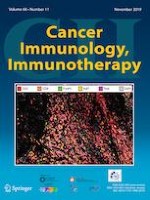Published in:

01-11-2019 | Lymphoma | Focussed Research Review
CD4+ T cells indirectly kill tumor cells via induction of cytotoxic macrophages in mouse models
Authors:
Bjarne Bogen, Marte Fauskanger, Ole Audun Haabeth, Anders Tveita
Published in:
Cancer Immunology, Immunotherapy
|
Issue 11/2019
Login to get access
Abstract
It is well recognized that CD4+ T cells may play an important role in immunosurveillance and immunotherapy against cancer. However, the details of how these cells recognize and eliminate the tumor cells remain incompletely understood. For the past 25 years, we have focused on how CD4+ T cells reject multiple myeloma cells in a murine model (MOPC315). In our experimental system, the secreted tumor-specific antigen is taken up by tumor-infiltrating macrophages that process it and present a neoepitope [a V region-derived idiotypic (Id) peptide] on MHC class II molecules to Th1 cells. Stimulated Th1 cells produce IFNγ, which activates macrophages in a manner that elicits an M1-like, tumoricidal phenotype. Through an inducible nitric oxide synthetase (iNOS)-dependent mechanism, the M1 macrophages secrete nitric oxide (NO) that diffuses into neighboring tumor cells. Inside the tumor cells, NO-derived reactive nitrogen species, including peroxynitrite, causes nitrosylation of proteins and triggers apoptosis by the intrinsic apoptotic pathway. This mode of indirect tumor recognition by CD4+ T cells operates independently of MHC class II expression on cancer cells. However, secretion of the tumor-specific antigen, and uptake and MHCII presentation on macrophages, is required for rejection. Similar mechanisms can also be observed in a B-lymphoma model and in the unrelated B16 melanoma model. Our findings reveal a novel mechanism by which CD4+ T cells kill tumor cells indirectly via induction of intratumoral cytotoxic macrophages. The data suggest that induction of M1 polarization of tumor-infiltrating macrophages, by CD4+ T cells or through other means, could serve as an immunotherapeutic strategy.